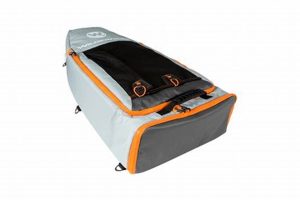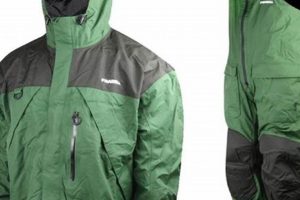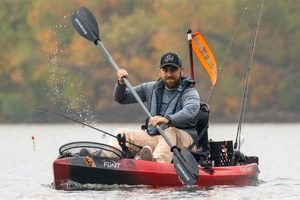Optimal terminal tackle configurations for kayak angling depend heavily on the target species and the fishing environment. For example, a simple Carolina rig with a live bait fish can be highly effective for targeting bottom-dwelling species like catfish or flounder in calmer waters, while a topwater lure rigged with a single hook is a popular choice for bass or other predatory fish in shallow, vegetated areas. The selection of hooks, line weight, leader material, sinkers, and floats must be carefully considered to maximize fishing success from a kayak.
Effective tackle setup significantly enhances fishing efficiency and enjoyment from a kayak. A well-chosen and properly configured rig improves hook-up ratios, reduces line tangles and break-offs, and allows anglers to present their bait or lure in the most natural and enticing way. Historically, kayak anglers have adapted traditional fishing rigs to suit the unique challenges and opportunities presented by kayak fishing. This has led to innovations in tackle design and the development of specialized rigs optimized for stability, ease of use, and limited storage space on a kayak.
Factors such as target species, water conditions, and fishing techniques will heavily influence the choice of tackle. Subsequent sections will explore specific rig recommendations for various scenarios commonly encountered by kayak anglers, covering everything from inshore saltwater fishing to freshwater lake and river systems. Additional considerations regarding kayak-specific tackle storage and management solutions will also be discussed.
Tips for Optimizing Kayak Fishing Tackle
Effective tackle configuration is crucial for successful kayak angling. These tips offer guidance on selecting and employing appropriate rigs.
Tip 1: Prioritize Compactness and Organization. Tackle storage space on a kayak is limited. Select versatile rigs and organize them in compact tackle boxes or trays for easy access and to prevent entanglement.
Tip 2: Match Tackle to Target Species. Research the preferred diet and habitat of target fish to determine appropriate hook sizes, line weights, and lure types. Matching tackle to the species significantly improves hook-up ratios.
Tip 3: Consider Water Conditions. Current, depth, and water clarity influence rig selection. Faster currents necessitate heavier weights, while deeper water may require longer leaders or downriggers. Adjust tackle accordingly.
Tip 4: Emphasize Simplicity. Complex rigs can be difficult to manage in the confined space of a kayak. Prioritize simple, effective rigs that are easy to tie and less prone to tangling.
Tip 5: Use Pre-Tied Rigs or Leaders. Pre-tied rigs save valuable time and effort on the water. This allows more time for fishing and reduces the need for intricate knot-tying in challenging conditions.
Tip 6: Choose Appropriate Rod and Reel Combinations. Shorter rods are often advantageous in kayaks due to space constraints. Select a reel with a smooth drag system and sufficient line capacity for the target species.
Tip 7: Practice Kayak-Specific Casting Techniques. Mastering casting techniques suitable for the limited space and mobility within a kayak is essential for accurate lure presentation and avoiding snags.
By adhering to these guidelines, anglers can significantly improve their efficiency and success while kayak fishing. Optimized tackle selection and organization contribute to a more enjoyable and productive experience on the water.
The subsequent conclusion will reiterate the importance of thoughtful tackle selection and offer further resources for enhancing kayak fishing proficiency.
1. Target Species
Target species identification is fundamental to determining optimal kayak fishing rigs. Physiological characteristics, feeding habits, and habitat preferences directly influence tackle and technique choices. For example, pursuing pelagic species like tuna or mackerel necessitates robust tackle capable of handling powerful runs and acrobatic leaps. Sturdy rods, high-capacity reels spooled with heavy braided line, and strong wire leaders are essential. Conversely, targeting bottom-dwelling species such as flounder or grouper requires different considerations. Shorter, more sensitive rods paired with lighter lines and appropriate sinkers become crucial for detecting subtle bites and effectively presenting bait near the seafloor.
Understanding the feeding behavior of the target species further refines rig selection. Ambush predators like largemouth bass often respond well to topwater lures and weedless rigged soft plastics fished near cover. These rigs allow anglers to entice strikes without becoming entangled in underwater obstacles. Species that primarily feed on crustaceans or mollusks, such as snapper or sheepshead, require specialized rigs designed to present small baits effectively. Dropper rigs with small hooks baited with shrimp or crabs prove highly effective in these scenarios.
In summary, effective kayak angling requires meticulous consideration of the target species. Rig selection must align with the unique anatomical features, feeding strategies, and habitat preferences of the intended quarry. This targeted approach maximizes the angler’s chances of success while promoting conservation by minimizing unintended bycatch.
2. Water Conditions
Water conditions significantly influence tackle choices for kayak angling. Current, depth, clarity, and temperature all play crucial roles in determining optimal rig configurations. Adapting to these dynamic variables maximizes fishing success from a kayak.
- Current
Current strength dictates weight and lure selection. Strong currents require heavier weights or lures to maintain bottom contact or achieve desired depths. Fast-moving water also necessitates streamlined lure profiles to minimize resistance and enhance action. Conversely, slow or still water allows for lighter tackle and more subtle presentations.
- Depth
Water depth influences line type, leader length, and sinker choices. Deep water often necessitates braided line for its sensitivity and minimal stretch, facilitating improved bite detection and hooksets. Longer leaders or specialized rigs like drop-shot rigs are frequently employed to present baits effectively at greater depths. Shallow water allows for shorter leaders, lighter lines, and simpler rigs.
- Clarity
Water clarity impacts lure color and presentation. Clear water often favors natural or translucent lure colors, while murky or stained water requires brighter, more visible colors. Lure visibility plays a crucial role in attracting fish and triggering strikes. In clear water, finesse techniques and subtle presentations often prove most effective.
- Temperature
Water temperature influences fish behavior and preferred forage, thus affecting lure choices. Colder water often slows fish metabolism, necessitating slower retrieves and smaller profile lures. Warmer water can trigger increased activity, allowing for faster retrieves and larger, more aggressive presentations. Matching lure selection to the prevailing water temperature maximizes effectiveness.
Considering these interconnected water conditions is essential for optimizing tackle configurations and maximizing kayak fishing success. Careful analysis of current, depth, clarity, and temperature ensures appropriate rig selection, enhancing lure presentation and increasing the likelihood of enticing strikes.
3. Kayak Stability
Kayak stability significantly influences rigging choices and overall fishing effectiveness. A stable platform allows for more aggressive hooksets, easier handling of larger fish, and the utilization of techniques requiring more movement or leverage. Conversely, less stable kayaks necessitate careful consideration of rigging to maintain balance and prevent capsizing. Choosing lighter tackle and employing techniques that minimize sudden shifts in weight distribution become crucial for maintaining stability in these situations.
For example, stand-up fishing, while offering increased visibility and casting range, requires a highly stable kayak and specialized rigging. Anglers fishing from sit-on-top kayaks with wider hulls and a lower center of gravity can employ heavier tackle and more dynamic techniques. This stability allows for confident hooksets and the ability to manage larger fish without compromising balance. In contrast, anglers fishing from narrower, less stable kayaks, such as sit-in models, must prioritize balance. Using lighter tackle and techniques that minimize movement becomes crucial to prevent capsizing, especially when fighting a strong fish or navigating challenging water conditions.
Understanding the relationship between kayak stability and rigging choices is paramount for both safety and fishing success. Matching rigging to the specific stability characteristics of the kayak ensures a balanced and efficient fishing platform. This allows anglers to focus on fishing technique and maximizes their chances of landing the target species while minimizing the risk of accidents. Prioritizing stability in rigging choices contributes to a safer and more enjoyable kayak fishing experience.
4. Simplicity and Ease of Use
In the context of kayak fishing, simplicity and ease of use are paramount for optimizing efficiency and enjoyment. Limited space, mobility constraints, and the dynamic nature of the on-water environment necessitate tackle configurations that are both effective and easy to manage. Prioritizing streamlined rigs reduces complexity, minimizes tangles, and allows anglers to focus on fishing rather than constantly adjusting their equipment.
- Reduced Tangling
Complex rigs with multiple components are more prone to tangling, especially in the confined space of a kayak. Simpler setups with fewer moving parts, such as a basic Texas rig or a Carolina rig with a fixed weight, significantly reduce the risk of line entanglement. This is crucial for maintaining fishing efficiency and minimizing frustration, particularly in challenging conditions.
- Quick Bait Changes
Rapid bait changes are often necessary when kayak fishing, especially when targeting different species or adapting to changing water conditions. Simple rigs facilitate swift and efficient bait swaps, maximizing fishing time and increasing the likelihood of success. For example, a pre-tied leader with a single hook can be quickly exchanged for another leader with a different hook size or bait type.
- Easy Handling in Confined Spaces
Kayaks offer limited space for tackle manipulation and storage. Simple rigs are easier to handle in these confined spaces, minimizing the risk of snags, tangles, and accidental hooksets. Compact tackle boxes and pre-rigged setups further enhance efficiency and organization within the kayak.
- Focus on Fishing
Simplified tackle configurations allow anglers to dedicate more attention to fishing itself rather than constantly adjusting and managing complex rigs. This enhanced focus improves situational awareness, reaction time to strikes, and overall fishing performance. Streamlined rigs enable anglers to fully immerse themselves in the experience and respond effectively to changing conditions or fish behavior.
Ultimately, prioritizing simplicity and ease of use in kayak fishing rigs contributes significantly to a more enjoyable and productive experience. By minimizing complexity and maximizing efficiency, anglers can fully embrace the challenges and rewards of kayak angling, focusing on the pursuit of fish rather than the intricacies of their equipment.
5. Storage Limitations
Storage limitations significantly influence tackle selection and organization for kayak anglers. Kayaks, by their nature, offer restricted storage compared to larger fishing vessels. This constraint necessitates careful consideration of tackle choices, prioritizing compact and versatile rigs over bulky or specialized equipment. Effective storage solutions maximize available space and ensure easy access to essential gear, contributing directly to a more efficient and enjoyable fishing experience.
Kayak anglers often employ modular tackle systems, utilizing small, interchangeable boxes or trays to organize lures, hooks, weights, and other terminal tackle. These systems maximize storage efficiency and allow for customization based on the target species and fishing techniques. Soft-sided tackle bags offer another storage solution, conforming to the kayak’s contours and maximizing space utilization. Prioritizing multi-purpose lures and rigs further reduces the need for numerous specialized items, conserving valuable storage space. For example, a single jerkbait can effectively target a variety of predatory fish, eliminating the need to carry multiple lures designed for specific species.
Understanding storage limitations inherent in kayak fishing is crucial for effective tackle management. Strategic organization, compact storage solutions, and versatile tackle choices maximize limited space, ensuring easy access to essential gear. Efficient storage practices ultimately contribute to a more streamlined and productive kayak fishing experience, allowing anglers to focus on fishing rather than managing cumbersome equipment. This optimization of space directly impacts the enjoyment and success of kayak angling.
6. Tangle-Free Design
Tangle-free design is a critical aspect of optimal kayak fishing rigs. The limited space and mobility inherent in kayak angling necessitate tackle configurations that minimize line entanglement. Tangled lines lead to lost fishing time, increased frustration, and potentially missed opportunities. Effective tangle-free rigs contribute significantly to a more efficient and enjoyable kayak fishing experience.
- Simplified Rig Construction
Rigs with fewer components and connections are inherently less prone to tangling. A simple Texas rig, for example, with its single hook and sliding weight, offers a streamlined profile that minimizes entanglement potential compared to more complex rigs with multiple hooks, swivels, or leaders. This simplicity is crucial in the confined space of a kayak, where line management becomes more challenging.
- Weedless Hooks and Lures
Weedless hooks and lures play a vital role in tangle prevention, especially when fishing in areas with heavy vegetation or submerged structure. The design of these hooks and lures minimizes snags and hang-ups, which are primary contributors to line tangles. Weedless rigging allows anglers to fish effectively in challenging environments without constantly battling tangled lines.
- Proper Line Management
Effective line management techniques, such as using line conditioners and maintaining appropriate tension during retrieves, further reduce tangling. Line conditioners reduce friction and prevent line from clinging to itself or the kayak. Maintaining consistent tension prevents slack line, which is highly susceptible to tangling, especially during drifts or when fighting a fish.
- Pre-Tied Leaders and Rigs
Utilizing pre-tied leaders and rigs simplifies tackle preparation and reduces the likelihood of on-the-water tangles. Pre-tied rigs are often constructed with high-quality components and optimized knot-tying techniques, minimizing weak points and tangle-prone connections. This preparedness streamlines the fishing process and allows anglers to focus on fishing rather than tackling tangles.
Ultimately, tangle-free design is paramount for efficient and enjoyable kayak fishing. By prioritizing simplified rigs, weedless tackle, proper line management, and pre-tied setups, anglers can minimize frustrating tangles and maximize their time on the water. This focus on tangle prevention directly translates to a more productive and rewarding kayak fishing experience.
Frequently Asked Questions about Kayak Fishing Rigs
This section addresses common inquiries regarding optimal tackle configurations for kayak fishing. Clarity on these points enhances angler preparedness and contributes to a more informed approach to tackle selection.
Question 1: What are the most versatile rigs for kayak fishing?
The Texas rig and the Carolina rig stand out for their versatility across various species and environments. The Texas rig excels in weedy or snag-prone areas, while the Carolina rig effectively probes deeper water or covers larger areas.
Question 2: How does kayak stability affect rig choice?
Kayak stability influences the angler’s ability to manage heavier tackle and larger fish. Stable kayaks permit more aggressive techniques and heavier lines, whereas less stable platforms necessitate lighter setups and more cautious handling.
Question 3: What are essential components of a kayak fishing tackle box?
Essential components include a selection of hooks, weights, swivels, leaders, pliers, line cutters, and a first-aid kit. Lure selection should reflect target species and anticipated fishing conditions. Compact organization is crucial for limited kayak space.
Question 4: How can line tangles be minimized while kayak fishing?
Tangles can be minimized by employing simpler rigs, using weedless hooks and lures where appropriate, maintaining proper line tension during retrieves, and utilizing pre-tied leaders or rigs. Careful line management is crucial in the confined space of a kayak.
Question 5: What are the benefits of using pre-tied rigs?
Pre-tied rigs save valuable time and effort, especially in challenging conditions. They also offer consistent quality and reliability, ensuring optimal knot strength and presentation. This is particularly beneficial for anglers new to fishing or specific rigging techniques.
Question 6: How should fishing rigs be stored on a kayak?
Rigs should be stored securely and accessibly in compact containers designed for kayak use. Tackle boxes with adjustable compartments, waterproof bags, and specialized kayak crate systems optimize organization and prevent gear from shifting or becoming damaged during transport.
Understanding these frequently asked questions equips anglers with the knowledge to make informed decisions regarding tackle selection and management. Optimized rigging enhances fishing efficiency, minimizes frustration, and ultimately contributes to a more successful and enjoyable kayak fishing experience.
The following section will offer concluding thoughts and additional resources for kayak anglers.
Conclusion
Optimal tackle configurations are essential for successful kayak fishing. Rig selection must consider target species, water conditions, kayak stability, simplicity, storage limitations, and tangle-free design. Versatile rigs like the Texas rig and Carolina rig offer adaptability across diverse fishing scenarios. Prioritizing compact, organized storage solutions maximizes limited space and enhances efficiency on the water. Understanding the interplay of these factors empowers anglers to make informed tackle choices, leading to increased success and enjoyment on the water. Careful consideration of these elements enhances fishing efficiency, reduces frustration, and maximizes enjoyment on the water.
Effective kayak angling requires a thoughtful approach to tackle selection and deployment. Adaptability to specific conditions and target species remains paramount for optimizing fishing outcomes. Continued exploration of rigging techniques and advancements in tackle design promise further enhancements in kayak fishing effectiveness. Diligent preparation and a commitment to continuous refinement of techniques contribute significantly to a rewarding and productive kayak fishing experience.





